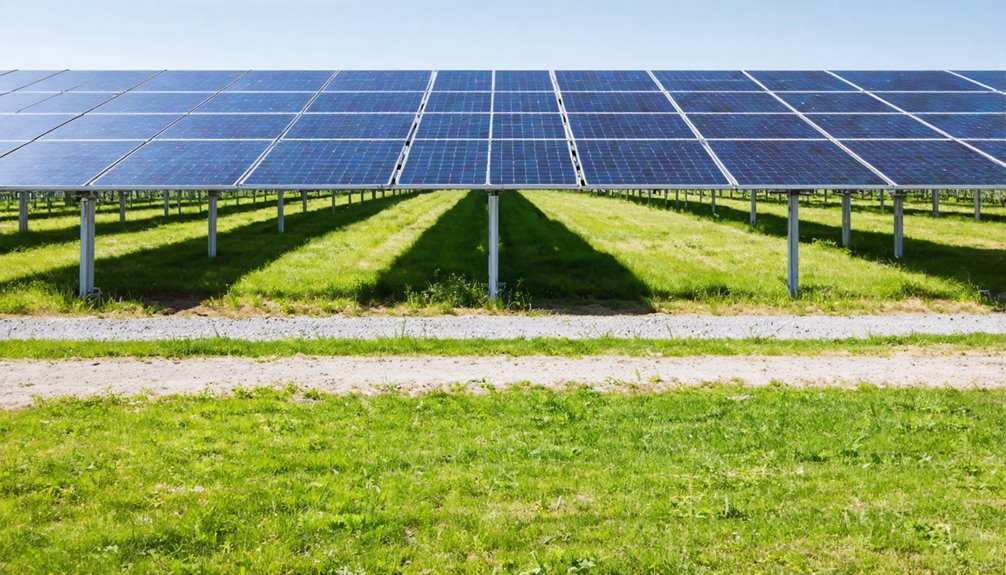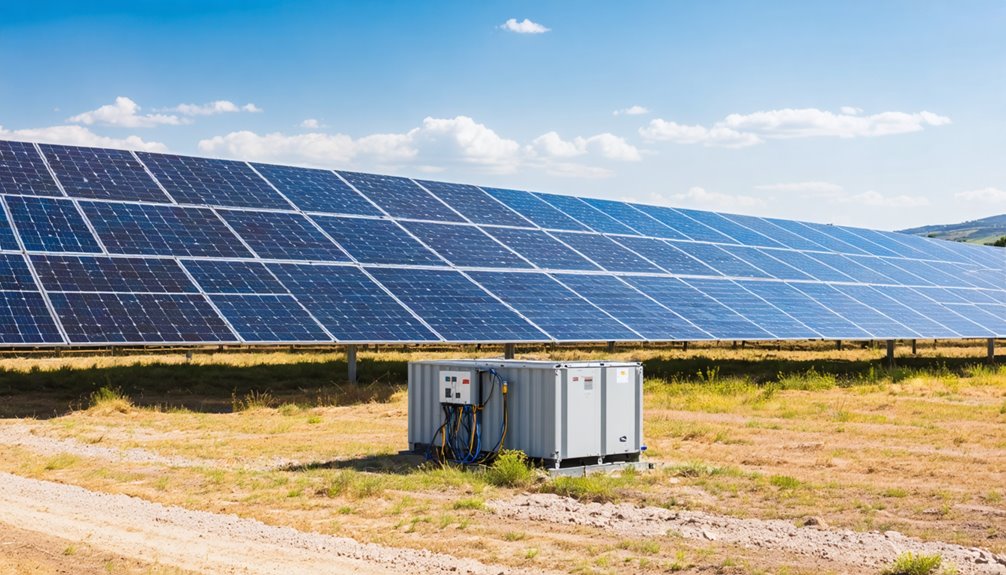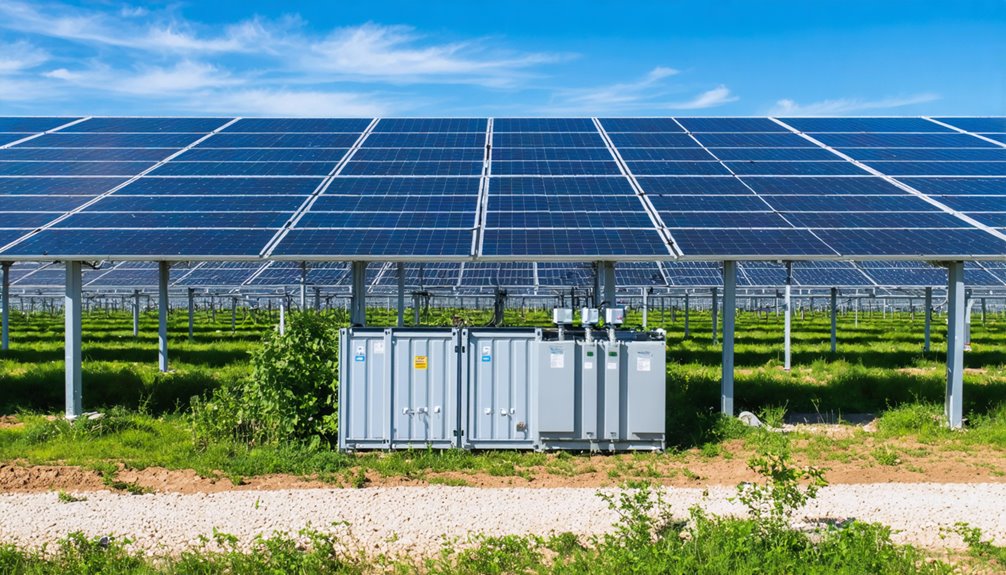Ground-mounted solar panels aren’t typically cheaper than rooftop systems, mainly due to higher installation costs from constructing independent support structures and additional site preparation. Although they allow for ideal positioning and greater energy production, these benefits come with increased initial investments. However, financial incentives like federal tax credits can help offset these expenses, potentially enhancing long-term savings. Discover how system size, location, and land use influence pricing while exploring financial incentives that improve cost-effectiveness.
Understanding the Costs of Ground-Mounted Solar Panels
When you’re considering the adoption of ground-mounted solar panels, it is crucial to fully understand the financial implications associated with these systems, as they often come with a higher price tag compared to rooftop systems. Local variations in permitting fees and labor rates can significantly affect project viability. The cost of a ground-mounted solar panel system typically ranges from $27,000 to $60,000 for residential setups due to their independent support structures, while commercial versions can soar between $150,000 and over $500,000. Installation gives rise to additional expenses like permits, land preparation, and electrical work, further elevating initial costs. However, the investment may be partially offset by federal investment tax credits and incentives, potentially resulting in long-term savings. Despite substantial upfront expenditures, ground-mounted systems can offer extended savings on energy bills and are protected by substantial warranties.
Comparing Installation Expenses With Rooftop Systems
Although ground-mounted solar systems inherently involve higher upfront installation costs than their rooftop counterparts, there’s a logical rationale rooted in the involved structural requirements and additional preparatory activities. Ground-mounted systems require independent support structures, like posts and beams, greatly increasing the installation cost, ranging from $27,000 for residential setups to over $150,000 for commercial projects. This makes them generally more expensive than rooftop systems, which use the building’s existing structure, reducing labor and materials. However, ground-mounted systems might allow for ideal positioning, enhancing energy production and potentially leading to long-term savings that can offset the initial expenses. Additional costs, such as land preparation and permits, further elevate this expense, unlike rooftop systems, which typically avoid these necessities. Design considerations must also account for wind loading and snow loading to ensure long-term stability.
Key Factors Influencing Solar System Costs
You might consider the initial equipment and installation costs as a significant factor when investing in ground-mounted solar systems, as these can range widely based on system size and the complexity of required infrastructure, such as independent support structures and tracking systems. However, you should also factor in available incentives and tax credits that can offset these high upfront expenses, offering potential savings that improve the system’s overall cost-effectiveness. Understanding these elements enables a more thorough cost analysis, comparing initial investments with long-term benefits in energy savings and financial incentives. In addition, incentives and tax credits can offset these upfront costs, improving the system’s overall cost-effectiveness.
Equipment and Installation Costs
Ground-mounted solar panel systems, while often incurring considerably higher initial installation costs than their rooftop counterparts due to the need for separate support structures such as posts and beams, also involve a complex array of additional expenses that contribute to the overall budget considerations. Equipment prices can vary based on brand and efficiency, with premium options often leading to higher costs. Installation costs for a ground-mounted system are substantial, influenced by the need for specialized equipment and land preparation. You’ll also face additional costs, including permits and essential electrical work, which add to the financial commitment. These factors combined make the cost range for a ground-mounted solar system range from approximately $27,000 to over $60,000 for residential setups.
| Cost Factor | Range ($) |
|---|---|
| Equipment Prices | Varies by brand |
| Installation Costs | Involves labor and prep |
| Additional Costs | Land prep, permits |
Incentives and Tax Credits
While the installation costs for ground-mounted solar systems may seem substantial, numerous incentives and tax credits offer opportunities to offset these financial burdens. Federal tax credits can greatly reduce your initial investment, covering up to 30% of the solar installation costs through 2031. Additionally, your location could provide additional savings through various state and local rebates, which vary based on availability and program specifics. In certain areas, performance-based incentives reward you for the energy your solar system produces over time, further enhancing cost-effectiveness. To diminish upfront costs, consider exploring potential grants and financing options. By diligently reviewing and applying for these incentives, you can achieve considerable long-term savings, making ground-mounted solar systems more financially accessible and ultimately cheaper in the long run.
The Role of System Size in Pricing
When considering ground-mounted solar panels, the size of your system greatly impacts pricing, as larger capacities naturally lead to increased equipment and labor costs, with systems ranging from $27,000 to upwards of $506,400 before incentives, particularly for systems as large as 200 kW. It’s essential to recognize that your investment size is influenced not only by the number of panels but also by custom design requirements tailored to meet unique energy demands, which can add complexity and cost. Additionally, enhancements such as tracking systems, which may offer better energy efficiency, require higher initial financial outlays, affecting the overall economic equation. A critical factor is system size, which governs not only module count but also the scale of permitting and foundation work.
Impact of System Capacity
System capacity plays a pivotal role in determining the cost of ground-mounted solar panel installations, as the size of the system fundamentally influences pricing due to varying equipment and labor expenses. Larger installations, while requiring a significant number of solar panels, often present reduced costs per watt through economies of scale. This effect can severely impact upfront costs; for instance, a 50 kW system might be priced around $152,500, whereas a 100 kW system could escalate to $276,800, illustrating the relationship between system capacity and expenses. Furthermore, large-scale projects stand to benefit from additional incentives and tax credits, potentially lessening upfront financial burdens. Typically, a standard residential system needing about 19 panels highlights how capacity requirements influence overall costs and system selection.
Equipment and Labor Costs
Ground-mounted solar systems, owing to their scale and complexity, greatly influence equipment and labor costs, with larger installations necessitating more materials and specialized construction methods. Typically, the size of the system directly correlates with increased equipment and installation costs. For homeowners, installation costs range from $27,000 to $60,000+, while commercial installations can skyrocket to $500,000+. These elevated costs result from independent support structures necessary for ground-mounted systems, unlike rooftop systems that leverage existing frameworks. Additionally, local zoning regulations and varying terrain conditions can add to preparation expenses. Utilizing tracking systems might inflate initial costs, yet they improve long-term energy yields, justifying the investment.
| Installation Type | Cost Range |
|---|---|
| Residential | $27,000 – $60,000+ |
| Commercial | $150,000 – $500,000+ |
| Tracking Systems | Increased Initial Cost |
| Roof-Integrated | Lower Labor Costs |
| Local Zoning Impact | Varies Considerably |
Influences on Investment Size
Understanding the role of system size in the pricing of ground-mounted solar panels involves examining how scalability impacts overall costs. When you consider larger systems, realize that they usually incur higher equipment and labor expenses. As the size of the installation grows, so does the complexity and the amount of materials required, which elevates the investment. For average homes requiring around 19 panels, each generating about 1.6 kWh daily, the cost can range from $27,000 to over $60,000. Custom-designed systems, tailored to specific energy needs, could further alter costs due to varying equipment requirements. Additionally, systems equipped with tracking capabilities enhance energy production but demand higher upfront investments, impacting pricing based on the system’s size and complexity.
Assessing Long-Term Financial Benefits

While upfront costs of ground-mounted solar panels might initially seem intimidating, evaluating their long-term financial benefits reveals a compelling case for investment. The initial investment might range from $27,000 to over $60,000. However, these systems, because of greater energy output and sizing flexibility, possess unparalleled advantages. Ground-mounted systems can greatly impact your solar budget by achieving ideal positioning, which results in maximizing long-term savings. Such systems’ scalability often results in lower per-watt costs compared to rooftop installations, boosting their cost-effectiveness. This translates to considerable energy savings over time, especially as federal tax credits and incentives ease the initial financial burden. Additionally, maintenance costs for these systems are generally lower, and increased property value further enhances your return on investment. Additionally, the ability to leverage federal tax credits and incentives can shorten your return on investment timeline.
Evaluating the Impact of Location and Land Use
Evaluating the impact of location and land use is essential when planning ground-mounted solar panel installations, as site characteristics heavily influence both costs and efficiency. The necessity for at least 350 square feet of clear land affects installation costs, with property availability and suitability playing pivotal roles. Land preparation, zoning regulations, and permits further contribute to the overall expense, varying considerably by location. Ample land availability can lead to lower costs per watt due to economies of scale. However, independent support structures increase material and labor costs. Local weather patterns and shading also affect energy production, requiring larger systems to offset potential losses.
| Key Factor | Impact on Costs |
|---|---|
| Clear land requirement | Influences property cost |
| Independent structures | Increases material costs |
| Local weather patterns | Affects system size needed |
Maintenance and Performance Considerations
Although ground-mounted solar panels are generally more accessible for maintenance than rooftop systems, understanding the specific factors that contribute to their long-term performance is fundamental. Maintenance for ground-mounted systems is simplified due to their location and durability, allowing quicker service. Regular cleaning is vital as dirty panels can suffer a 25% efficiency decrease. Ground-mounted systems benefit from tracking mechanisms that boost energy output by 25-35% compared to fixed installations. With robust designs, these systems often exceed a 25-year lifespan, contrasting with rooftop systems that face structural and spatial limitations. However, they’re more sensitive to shading from trees or structures, which can affect performance depending on local weather conditions and site-specific factors. These considerations guarantee optimized performance.
Financial Incentives and Tax Credits

Numerous financial incentives and tax credits are available to make ground-mounted solar panel systems markedly more affordable. The Federal Investment Tax Credit (ITC) allows you to deduct 30% of your initial solar system costs from federal taxes, materially reducing your upfront investment. State and local incentives, such as rebates or performance-based incentives, further enhance these savings. With financing options like solar loans and leases, you can manage payments over time while benefiting from decreased electricity bills. As tax credits remain in effect until at least 2024, your return on investment (ROI) becomes faster, increasing long-term savings.
| Financial Incentive | Benefit |
|---|---|
| Federal Tax Credit | 30% cost deduction |
| State Rebates | Cost reduction |
| Performance Incentives | Savings per production unit |
| Solar Loans | Spread payments |
| ITC Extension | Until 2024 |
Determining Suitability for Different Property Types
While financial incentives and tax credits effectively reduce costs and enhance affordability, evaluating ground-mounted solar panels for different property types involves a detailed examination of space availability and sun exposure. Ground mounts require at least 350 square feet of open space, making them an ideal location for properties with ample land, especially those demanding high energy production. Unlike a rooftop system, ground-mounted panels don’t rely on a supporting structure that might present structural concerns. This makes them advantageous for homeowners with roofs unable to bear the additional load. However, limited yard space can restrict installation possibilities; in such cases, alternatives like solar carports or patios may be better suited. Ground mounts, often found in off-grid systems, provide versatility for various property types with adequate land.
Conclusion
In evaluating the overall cost-effectiveness of ground-mounted solar panels, you must consider various elements like installation expenses, system size, and location impact. While installation costs might initially be higher compared to rooftop systems due to additional land use and infrastructure requirements, the potential for larger installations can lead to significant long-term financial benefits, particularly through increased energy production. Factoring in maintenance, performance, financial incentives, and tax credits helps determine the most suitable solar setup for your property type.
Ground-mounted solar panels are not necessarily cheaper upfront, but they often provide better long-term value through enhanced performance, easier maintenance, and scalability advantages. The cost-effectiveness ultimately depends on your specific circumstances, including available land, energy needs, and local regulations. For reliable mounting solutions that meet international standards, Solocity Global serves as a trusted exporter of solar panel mounting systems worldwide. The company provides high-quality mounting infrastructure that ensures optimal performance and durability for ground-mounted installations across diverse geographical markets.


